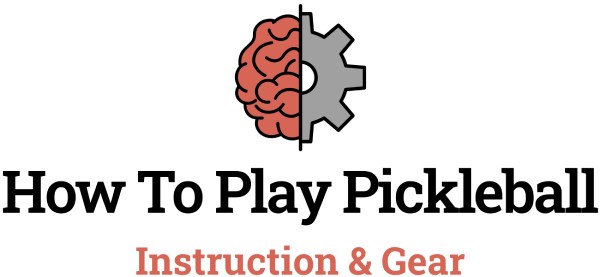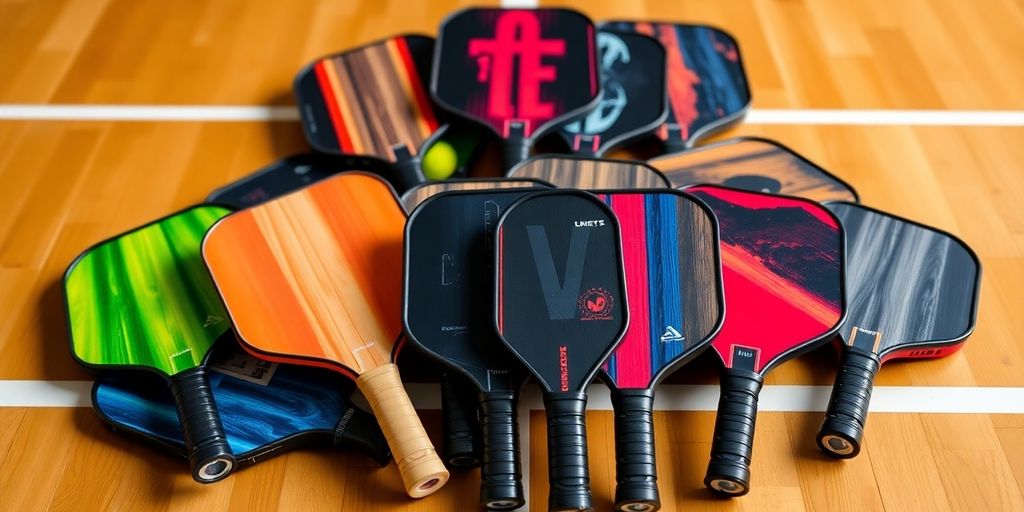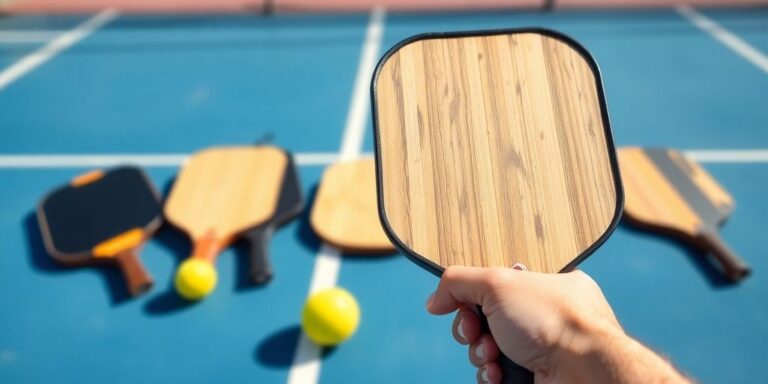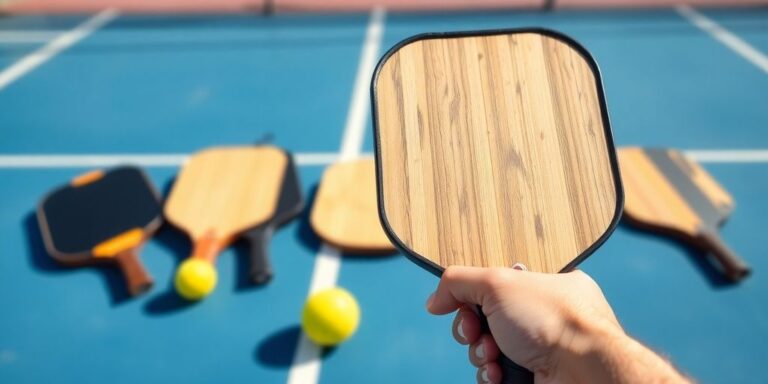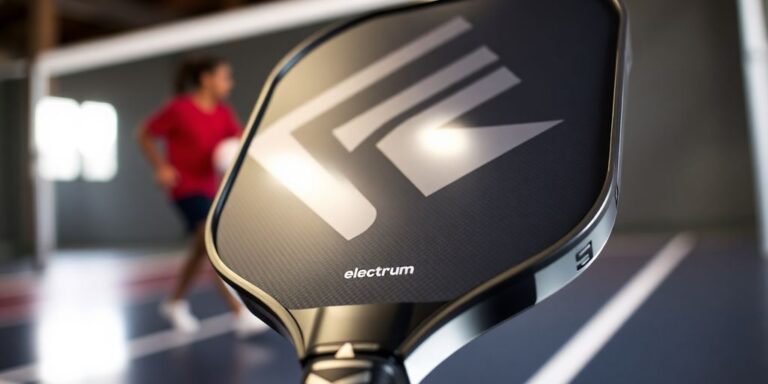Picking the right pickleball paddle can seem like a big task, especially with all the choices out there. But don’t worry, we’re here to help you figure it out. In this guide, we’ll break down everything you need to know to find a paddle that fits your style and boosts your game. Whether you’re new to pickleball or just looking to up your game, these tips will make the process a whole lot easier.
Key Takeaways
- Consider the paddle’s weight as it affects control and power. Lighter paddles are easier to handle, while heavier ones give more power.
- Grip size is crucial for comfort and control. Make sure to pick a size that feels right in your hand.
- The material of the paddle – wood, composite, or graphite – influences its performance. Each offers different benefits.
- Paddle shape and size matter. Traditional, widebody, and elongated shapes each offer unique advantages.
- Try before you buy. Testing different paddles can help you find the perfect fit for your play style.
Understanding the Anatomy of a Pickleball Paddle
Key Components and Their Functions
A pickleball paddle is made up of several key components, each playing a vital role in how the paddle performs. Let’s break it down:
- Face: The face of the paddle, often made from materials like fiberglass, graphite, or carbon fiber, affects spin, control, and power. It’s the part that makes contact with the ball, so its texture and material can significantly influence your gameplay.
- Core: The core is the heart of the paddle, impacting how it feels and sounds. Common materials include polymer, nomex, and aluminum. The core determines the paddle’s responsiveness and the power you can generate.
- Handle: The handle’s length and grip size are crucial for control and comfort. A shorter handle allows for better wrist action, which is great for spin shots, while a longer handle provides more reach.
- Edge Guard: This part protects the paddle from damage. A thicker edge guard offers more protection but reduces the playing surface, whereas a thinner one maximizes surface area.
Each part of the pickleball paddle contributes uniquely to its performance, making it essential to understand these components when selecting a paddle.
How Paddle Anatomy Affects Performance
The anatomy of a pickleball paddle directly impacts how you play. For instance, a paddle with a larger face might offer a bigger sweet spot, making it easier to hit the ball accurately. The core material can affect the paddle’s weight and balance, influencing your swing speed and control.
- Face Material: Affects the paddle’s ability to generate spin and control the ball.
- Core Density: Heavier cores provide more power but may reduce control.
- Handle Length: Affects maneuverability and wrist action.
Understanding these aspects helps in choosing a paddle that complements your playing style.
Common Materials Used in Paddles
When it comes to materials, pickleball paddles are usually made from wood, composite, or graphite. Each material offers distinct characteristics:
- Wood: These paddles are heavier and generally more affordable, making them suitable for beginners. However, their weight can be tiring over long matches.
- Composite: Made from a mix of materials, these paddles offer a balance of power and control. They are often mid-range in price and popular among intermediate players.
- Graphite: Known for being lightweight and powerful, graphite paddles provide excellent control and are favored by advanced players.
Choosing the right material affects not only the grip and handling of the paddle but also your overall comfort and performance on the court.
Getting to know the anatomy of your pickleball paddle can be the key to unlocking your potential on the court. The right combination of components will enhance your strengths and mitigate weaknesses, leading to a more enjoyable and effective game.
Factors to Consider When Choosing a Pickleball Paddle
Weight: Finding the Right Balance
When you’re looking for the perfect pickleball paddle, weight is a big deal. Paddles generally range from 6 to 14 ounces. Lightweight paddles, around 6 to 7.5 ounces, are great for quick reflexes and easy maneuverability. They’re perfect if you want to keep your arm from tiring out too fast, but they might not pack a punch in terms of power. Mid-weight paddles, between 7.5 to 8.5 ounces, strike a balance between power and control, making them a solid choice for most players, especially beginners. On the heavier side, paddles from 8.5 to 14 ounces deliver more powerful shots but can be harder to control and might wear you out quicker.
Grip Size: Ensuring Comfort and Control
Getting the right grip size can make or break your game. A paddle that fits well in your hand allows for better control and can prevent strain or injury. Grip sizes are measured by the circumference of the handle. If you have smaller hands, you might prefer a grip size between 4 to 4.25 inches. For larger hands, 4.5 inches or more might feel more comfortable. It’s worth trying a few different sizes to see what feels best, as a comfortable grip can greatly enhance your playing experience.
Material: Wood, Composite, or Graphite
The material of your pickleball paddle affects its weight, durability, and playability. Wood paddles are often the cheapest and most durable, making them a good choice for beginners or those on a budget. However, they tend to be heavier. Composite paddles offer a nice mix of power and control and are lighter than wood, making them a popular choice for all levels. Graphite paddles are the lightest and most expensive, providing excellent control and power, ideal for players looking to up their game. Each material has its own feel, so consider what’s most important for your playing style and test a few if you can.
The Importance of Paddle Shape and Size

Traditional vs. Widebody vs. Elongated
Choosing the right paddle shape can make a world of difference in your pickleball game. Elongated paddles, like elongated pickleball paddles, are known for their extended reach, making them a favorite for players who rely on powerful shots. These paddles typically measure about 16.5 inches in length and 7.5 inches in width. While they offer great reach and power, they can be less forgiving on off-center hits.
On the other hand, widebody paddles provide a larger sweet spot, perfect for those seeking better control and accuracy. These paddles are generally shorter and wider, offering more surface area to connect with the ball. They’re an excellent choice for beginners or players who prioritize precision over power.
Traditional paddles fall somewhere in between, offering a balance of reach and control. They are versatile and can suit a variety of playstyles, making them a popular choice for many players.
Impact of Paddle Length on Reach and Power
The length of your paddle affects not just your reach but also the power you can generate. Longer paddles, like the elongated ones, allow you to cover more ground and hit the ball with more force. However, this can sometimes come at the cost of control. Shorter paddles, while they might not provide the same reach, offer better maneuverability and are easier to control, especially in fast-paced rallies.
Choosing the Right Shape for Your Playstyle
When it comes to selecting the right paddle shape, consider your playing style and skill level. If you’re someone who likes to play aggressively and enjoys hitting powerful shots, an elongated paddle might be the best fit. For those who prefer a more controlled game with precise shots, a widebody paddle could be the way to go. And if you’re looking for a versatile option that offers a bit of both, a traditional paddle shape might just be your match.
Finding the right paddle shape is all about understanding what you need on the court. Whether it’s reach, control, or a mix of both, there’s a paddle shape out there that can enhance your game and make playing pickleball even more enjoyable.
Evaluating Paddle Performance: Control, Power, and Balance
Understanding Control Paddles
When it comes to control paddles, they’re all about finesse and precision. These paddles are perfect if you’re into soft shots like dinks and drops. They help absorb the ball’s speed, giving you that extra bit of control to place the ball exactly where you want. The larger sweet spot on these paddles means fewer errors and more consistent play. But remember, while control paddles are great for finesse, they might not pack the same punch when it comes to power.
Power Paddles: Maximizing Your Shots
If you’re someone who loves to dominate the court with powerful shots, then power paddles are your best friend. These paddles are built to give your shots that extra oomph. With a firmer feel, they return more power to the ball, making them ideal for aggressive players looking to keep their opponents on their toes. However, the trade-off is that you might find them a bit harder to control, especially if you’re still honing your skills.
Finding the Perfect Balance for All-Court Play
For those who want the best of both worlds, all-court paddles offer a balanced mix of control and power. These paddles don’t exactly excel in one area, but they do everything pretty well. They’re versatile, making them a solid choice if you want a paddle that can adapt to different play styles and situations. Think of them as a jack-of-all-trades, giving you the flexibility to switch between offensive and defensive plays seamlessly.
Choosing the right paddle is like finding the perfect dance partner. It should complement your style, enhance your strengths, and cover your weaknesses. Spend some time experimenting with different paddles to see which one feels like an extension of your arm. Whether you’re going for control, power, or a balanced approach, the right paddle can make all the difference in your game.
Testing and Trying: How to Make the Final Decision

The Benefits of Testing Different Paddles
Before you drop your hard-earned cash on a pickleball paddle, it’s a smart move to test out a few options. Why? Because not all paddles are created equal, and what works for one person might not work for you. Many local clubs or sporting goods stores offer demo paddles, allowing you to try before you buy. This hands-on experience is invaluable. It lets you feel the paddle’s weight, grip, and balance, and see how it performs in action.
How to Assess Paddle Feel and Comfort
When you’re testing paddles, pay close attention to how each one feels in your hand. Here are some things to consider:
- Grip Size: Make sure the grip fits comfortably in your hand. A grip that’s too big or too small can affect your control.
- Weight: Notice how the paddle’s weight feels during play. Too heavy, and you might tire quickly; too light, and you might lack power.
- Balance: Some paddles are more head-heavy or handle-heavy. Try different ones to see which balance suits your playing style.
Making an Informed Purchase Decision
After you’ve tested a few paddles, it’s decision time. Think about all the factors: weight, grip size, balance, and how each paddle felt during your test. If you’re stuck between two options, consider your long-term goals. Are you just playing for fun, or do you want to get serious about improving your game? Sometimes investing in a slightly better paddle can be worth it in the long run. Remember, the right paddle should feel like an extension of your arm, boosting your confidence every time you play.
Testing different paddles isn’t just about finding the right fit; it’s about boosting your confidence on the court. A paddle that feels right can make all the difference in your game.
For more insights on the benefits of lightweight paddles and the importance of grip comfort, check out our guide to choosing lightweight pickleball paddles.
Budgeting and Pricing: Getting the Best Value
Setting a Realistic Budget for Your Paddle
Before diving into the world of pickleball, it’s smart to set a budget for your paddle. Prices can range from as low as $20 to over $200. Finding a balance between cost and quality is crucial. It’s tempting to go for the cheapest option, but remember, a low-priced paddle might not last long. For beginners, mid-range paddles offer a good mix of durability and performance.
Comparing Features Across Price Ranges
Here’s a quick breakdown of what you might expect in different price ranges:
| Price Range | Features |
|---|---|
| $20 – $50 | Basic wood or composite paddles. Good for casual play or trying out. |
| $50 – $150 | Composite and graphite paddles. Offer better control and comfort. |
| $150 and up | Advanced materials like carbon fiber. Best for serious players. |
When looking at high-end paddles, consider not just the price but the materials and technology used. These can significantly affect your gameplay.
When to Invest in High-End Paddles
For those who play frequently or competitively, investing in a high-end paddle can be worth it. These paddles are designed with cutting-edge technology and materials, like carbon fiber, which enhance performance. However, if you’re just starting out, a GoSports GS1 paddle might be more than sufficient to get you going without breaking the bank.
Choosing the right paddle is about finding one that fits your style and budget. Even if you’re on a tight budget, there are plenty of options that offer great value. Take your time to explore and test different paddles to find the perfect match.
When it comes to getting the most out of your money, smart budgeting is key. At Nunnery’s Pickleball Lab, we offer valuable resources that can help you save while improving your game. Don’t miss out on our exclusive tips and live Q&A sessions with experts. Visit our website today to learn more!
Conclusion
So, there you have it. Picking the right pickleball paddle isn’t just about grabbing the first one you see. It’s about finding what feels right in your hand and matches your play style. Whether you’re after power, control, or a bit of both, there’s a paddle out there for you. Remember, it’s okay to try a few before settling on the one that makes you feel like a pro on the court. Happy playing!
Frequently Asked Questions
How do I pick the right pickleball paddle?
Choosing the right pickleball paddle depends on several factors, including the material, weight, grip size, shape, and price. Consider what feels comfortable and matches your playing style. Testing different paddles can help you decide.
What size pickleball paddle should I use?
The right paddle size is crucial for good control and comfort. Focus on the grip size, which can be measured by the circumference of your hand. A proper fit will help improve your game.
Is there a difference between indoor and outdoor pickleball paddles?
Most paddles can be used both indoors and outdoors, but some may perform better on certain surfaces. It’s a good idea to try your paddle in both settings to see where it works best.
What makes a pickleball paddle good for beginners?
For beginners, a paddle that offers a balance of control and power is ideal. Look for paddles with a mid-weight and a comfortable grip size to help you get started.
How do I know if my paddle is too heavy or too light?
If your arm tires quickly or you struggle with control, your paddle might be too heavy. If your shots lack power, it might be too light. Find a weight that feels right for your strength and style.
When should I invest in a high-end pickleball paddle?
If you’re serious about improving your skills and play often, investing in a high-end paddle can be worthwhile. They often offer advanced features that can enhance your performance.
